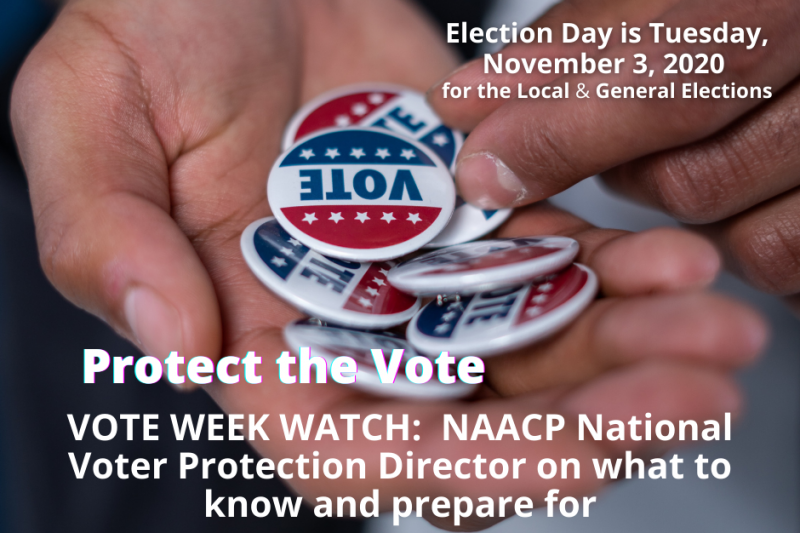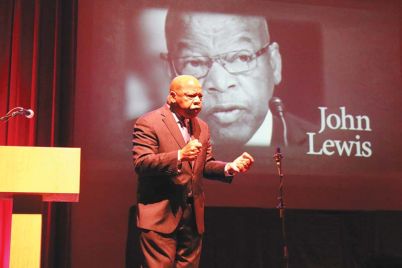Stephanie Owens, director of the NAACP’s National Voter Protection Project and founder of Women Talk Black joined the Foundation for a Healthy St. Petersburg on Friday, October 30, to review issues that voters should be aware of approaching voting day on Tuesday, November 3.
Owens also had recommendations for what voters should be prepared for during the weeks immediately following the vote – including mis-and-disinformation campaigns, social media confusion, and negative commentary on websites masked as Black and Brown advocacy sites.
“In the Tampa Bay area, some things are true in some counties but are not true in other counties,” Owens noted early on in the conversation. She encouraged those who were in the position to receive questions from both sides of the bridge to point voters to the specific sites for their county. In Pinellas, that website is VotePinellas.com. In Hillsborough, the site is VoteHillsborough.org.
Owens said negative messaging like, “Does it even matter who I vote for?” or “Does my vote even count?” could be found on deceptive sites posing as Black and Brown advocacy hubs.
“The disinformation is extraordinarily frightening; there are organizations who have spent a lot of time, since 2016, as a matter of fact, to build a presence, as if they are true Black and Brown organizations in our communities. So, there are many websites that look extraordinarily credible, but are not.”
Owens said in the past three months, some of these sites started to change their messaging — a repeat of exactly what they did in 2016 – littering it with confusing information and ideas intended to dissuade voters from going to the polls. She encouraged viewers to be careful about what sites they were getting, and sharing, information from.
Another kind of voter suppression is giving false “alternate” ways to cast ballots. “Most of the time, it’s things like [stating] the post office has extended the time that they’re going to mail your ballots or something like that; it sounds like it could be a legitimate thing, but it’s not true.”
Owens also wanted organizations to make it clear that at this point, there should absolutely be “no ballots [being cast] in the mail. At this point, you’re either going to take your ballot to the drop off location, or you’re going to surrender your ballot and vote in person.”
Drop off locations are NOT OPEN on November 3. If you are voting on November 3, you will need to know where your polling place is in order to surrender your mail-in-ballot and cast your vote in your assigned polling place.
Owens added that before November 3, “You do not have to have your ballot with you, should you decide to vote in person. That is not a requirement.” She said while having the ballot makes it much easier, “If you just happen to be out and you’re passing a Supervisor of Elections office or any other early vote location, and you decide ‘I think I’d rather just vote in person,’ you have the opportunity to do that. The Supervisor of Elections will check the status of your ballot, and they will see that you haven’t returned it because it’s still in your kitchen.”
For those who have already dropped off or mailed in their ballot but have checked and found it has not been received at VotePinellas.com or VoteHillsborough.org, Owens shared other recommendations.
“If you’ve returned your ballot, and you visit the Supervisor of Elections website, put in your information, and you see that your ballot has not been received, then you will be able to cast a regular ballot,” she noted — if it still says it’s not received when you go to the polling place. A poll work or supervisor at the election site will be able to help you when you speak to them about it.
However, if it says your ballot has been received – even if it doesn’t say it’s been counted, you can NOT vote. If it says your ballot has been received, said Owens, then “You have essentially voted. The reason that’s important, it’s illegal to vote twice. If your ballot is showing that it’s received, and you’re just worried that it hasn’t been counted, don’t worry, but also don’t vote — because your ballot has officially been received.”
Owen said this more than likely means your ballot is in the queue to be counted and recommended taking a screenshot of your having looked it up online, and the date that it says it’s been received.
She added that the supervisors of elections are required by law to notify you when they receive your ballot. If there’s a problem with your vote by mail it can also be fixed through what is called the curing process. Owens said that voters have until five o’clock Thursday to cure any challenges with their ballot.
While supervisors of elections have the ability to notify voters by letter or phone if the voter included that information on the back of their mail-in envelope, voters should be aware that any call that comes may not indicate that the call is coming from the Supervisor of Elections office.
This is because, while caller ID should say Supervisor of Elections office, the volume of votes may mean that new, temporary employees may be brought in to help make phone calls, and the phone they call from may not ID itself as coming from a county elections office. While many people normally won’t pick up a call that doesn’t have an official-sounding caller ID, in this election, If you don’t pick up that call, said Owens, “now someone’s just called to tell you there’s something wrong with your ballot. But you didn’t take that call.”
This means if a person feels like they might have a challenge with their ballot, it’s important for them to be cognizant that the call may come from an unidentified number. Owens reaffirmed that this voting season, “tracking the ballot is extraordinarily important.”
She also noted it’s important for people to know that it might be days before all the votes are counted.
A video from the Voting Rights Lab “Be Patient” states it can take up to seven days after the election to make sure all the absentee votes are counted. The catch little video shares the multiple steps it will take to count all the votes, including 1) sorting, 2) verification, 3) opening, 4) scanning and review, 5) tabulation, 6) results reported, and finally, 7) results certified.
Owens also shared about the SeeSay2020 tool and website, which has been developed for reporting questionable activities and incidents at the polls.




